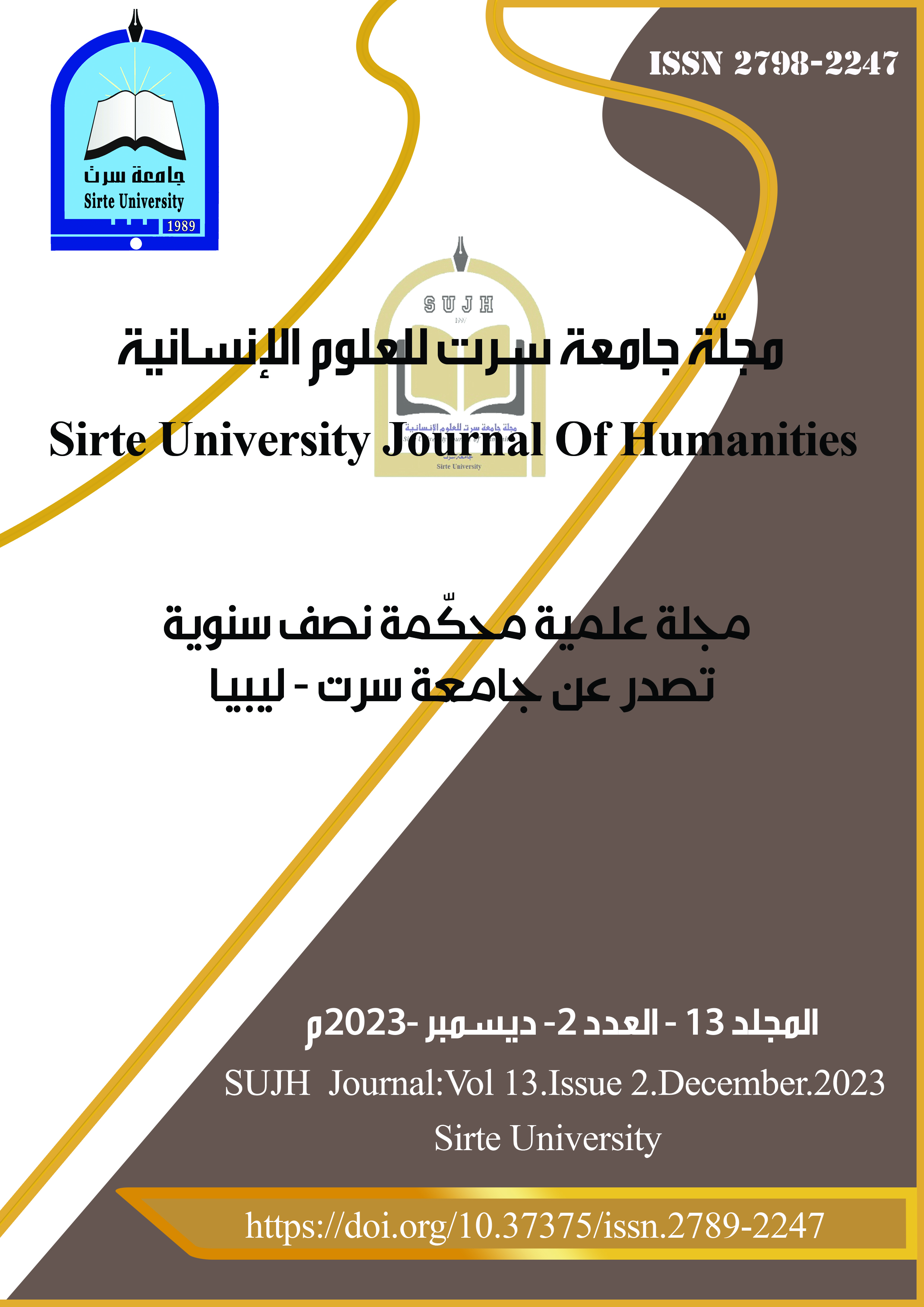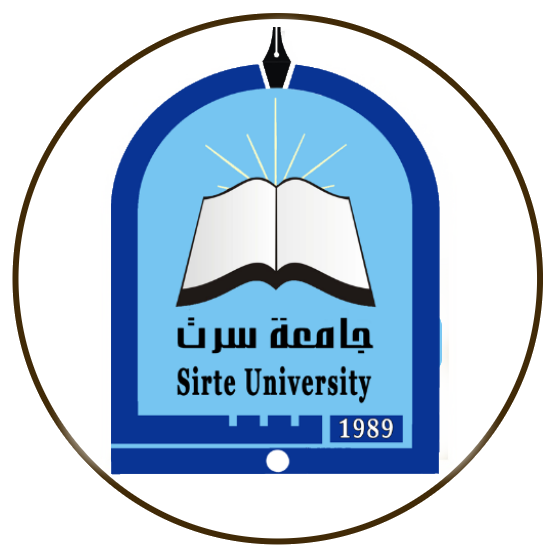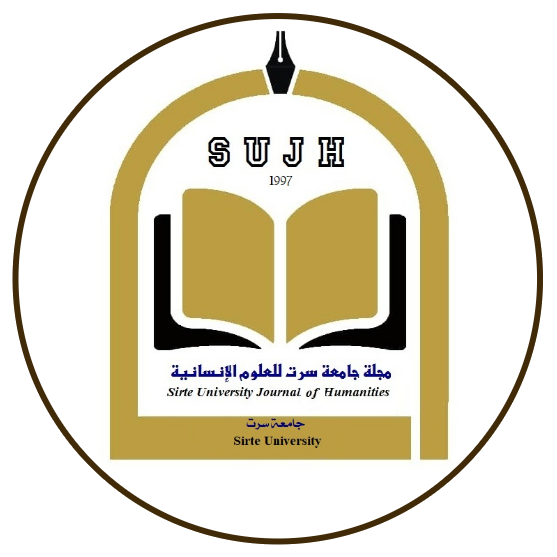An Investigation into Approaches to Learning Adopted by Undergraduate EFL Learners
DOI:
https://doi.org/10.37375/sujh.v13i2.2412الكلمات المفتاحية:
وجهات النظر، أساليب التعلم، اللغة الإنجليزية كلغة أجنبية، متعلمو اللغة الانجليزية.الملخص
إن وجود اختلافات والتباس في طرق تعلم اللغة الإنجليزية يشكل تحديات حاسمة للتحقيق في الأساليب التي قد تثري أو تعيق كيفية قيام متعلمي اللغة الإنجليزية بالتعلم. تناولت هذه الدراسة أساليب تعلم اللغة الإنجليزية التي يتبناها طلاب المرحلة الجامعية. بالإضافة إلى ذلك، تم فحص ما إذا كان هناك اختلاف بين أساليب التعلم التي يتبعها الطلاب في الأقسام المختلفة بكلية التربية- جامعة سرت. تم جمع البيانات كميًا من 70 طالب باستخدام استبيان عملية الدراسة الخاص بـ Biggs (SPQ) كأداة تشخيصية لتقييم أساليب الطلاب في التعلم. أشارت النتائج إلى أن معظم الطلاب اعتمدوا الطرق السطحية. و حصلت هذه الأساليب في التعلم على أعلى متوسط درجات (M = 4.55) ) في حين كانت الأساليب العميقة منخفضة (M = 1.77) . وأوضحت النتائج أيضًا الاختلافات بين أساليب الطلاب في تعلم اللغة الإنجليزية في الأقسام المختلفة. توفر النتائج الرئيسية مدخلات للمؤسسات الأكاديمية حول عملية التعلم وتكون بمثابة مرجع لاتخاذ القرار وتحسين أساليب التعلم للطلاب. وقد تم تقديم اقتراحات للمعلمين وواضعي السياسات التعليمية والبحوث المستقبلية بالتفصيل في هذه الدراسة.
المراجع
- Abosnan, S. H. (2016). The teaching of reading English in a foreign language in Libyan
- universities: Methods and models (Doctoral dissertation, University of Glasgow).
- Ahmed, S. (2015). Attitudes towards English Language Learning among EFL Learners at UMSKAL. Journal of Education and Practice, 6(18), 6-16.
- Al-Mahrooqi, R., Denman, C., Al-Siyabi, J., & Al-Maamari, F. (2015). Characteristics of a good EFL teacher: Omani EFL teacher and student perspectives. SAGE Open, 5(2), 1-15.
- Alqarni, N. (2023). Language learning strategies and learning engagement as predictors of language learning achievement: an investigation of Saudi EFL learners. Saudi Journal of Language Studies.
- Alshehri, E. (2014). Motivational strategies: The perceptions of EFL teachers and students in the Saudi higher education context (Doctoral dissertation, University of Salford).
- Arends, R. (2014). Learning to teach. McGraw-Hill Higher Education.
- Biggs, J. B., & Collis, K. F. (1982). Evaluating the quality of learning: The SOLO taxonomy (Structure of the Observed Learning Outcome). Academic Press.
- Biggs, J. B. (1987). Student Approaches to Learning and Studying. Research Monograph. Australian Council for Educational Research Ltd., Radford House, Frederick St., Hawthorn 3122, Australia.
- Biggs, J. B. (1989). Approaches to the enhancement of tertiary teaching. Higher Education Research and Development, 8(1), 7-25.
- De Houwer, J., Barnes-Holmes, D. & Moors, A. (2013). What is learning? On the nature and merits of a functional definition of learning. Psychon Bull Rev 20, 631–642. https://doi.org/10.3758/s13423-013-0386-3
- Chin, C., & Brown, D. E. (2000). Learning in science: A comparison of deep and surface approaches. Journal of Research in Science Teaching: The Official Journal of the National Association for Research in Science Teaching, 37(2), 109-138.
- Chue, K. L., & Nie, Y. (2016). International students’ motivation and learning approach: A comparison with local students. Journal of International Students, 6(3), 678-699.
- Cohen, L. Manion, L., Morrison, K. (2007). Research methods in education (6th ed). Routledge Publication.
- Creswell, J.W., & Plano Clark, V. L. (2011). Designing and conducting mixed methods research (2nd ed.). London and Thousand Oaks, CA: Sage Publications.
- Creswell, J. W. (2013). Qualitative inquiry and research design: Choosing among five approaches (3rd ed.). London and Thousand Oaks, CA: Sage Publications.
- Duff, A., Boyle, E., & Dunleavy, K. (2002). The relationship between personality, approach to learning, emotional intelligence, work attitude and academic performance. In The 7th annual ELSIN conference (pp. 141-151).
- English Proficiency Index (2022). EF English Proficiency Index.. https://www.ef.com/ca/epi/
- Entwistle, N., & Tait, H. (1990). Approaches to learning, evaluations of teaching, and
- preferences for contrasting academic environments. Higher education, 19(2), 169-194.
- Fung, L. Y. (2010). A study on the learning approaches of Malaysian students in relation to English language acquisition. American Journal of Scientific Research, 9, 5-11.
- Goh, P. S. C. (2008). Teaching Practices That Hinder the Deep Approaches to Learning of Twinning Programme Students in Malaysia: A Qualitative Perspective. The Asia-Pacific Education Researcher, 17(1), 63–73.
- Goh, P. S. C. (2016). Preservice teachers’ approaches to learning and their learning outcomes: A Malaysian Experience. In The Psychology of Asian Learners (pp. 203-216). Springer, Singapore.
- Hasnor, H. N., Ahmad, Z., & Nordin, N. (2013). The relationship between learning approaches and academic achievement among Intec students, Uitm Shah Alam. Procedia-Social and Behavioral Sciences, 6(90), 178-186.
- Hattie, J. A. C., & Anderman, E. (2013). International guide to student achievement. New York, NY: Routledge.
- Kadija, F. (2019). Enhancing Students’ Engagement in Learning through YouTube based Instruction. International Journal of English and Studies, 1(4)1-6.
- Kadija, F. (2022). Difficulties Facing English Foreign Language University Students in Using English Prepositions. The Faculty of Arts Journal, (51).
- 3of Language Teaching and Learning, 3(2), 30-39.
- Marton, F., & Säljö, R. (1976). On qualitative differences in learning: I—Outcome and process. British Journal of Educational Psychology, 46(1), 4-11.
- Marton, F., & Booth, S. A. (1997). Learning and awareness. psychology press.
- Qureshi, S., & Ullah, R. (2014). Learning experiences of higher education students: Approaches to learning as measures of quality of learning outcomes. Bulletin of Education and Research, 36(1), 79-100.
- Sabourin, B. (2016). Identifying Student Approaches to Learning: Undergraduate Student Perceptions of Teaching and Learning at the University of Windsor. (Doctoral dissertation, University of Windsor, Canada).
- Swee-Choo, P. G. (2008). Teaching practices that hinder the deep approaches to learning of twinning programme winning programme students in Malaysia: A qualitative perspective. Asia-Pacific Education Researcher, 17(1), 63-73.
- Teoh, H. C., Abdullah, M. C., Roslan, S., & Daud, S. M. (2014). Assessing students’ approaches to learning using a matrix framework in a Malaysian public university. Springer Plus, 3(1), 54-62.
- Teoh, H. Yap, T. (2015). Student approaches to learning among university students. American Journal of Applied Psychology. 4, (3-1)15-20.
- Van Waes, S., Vanthournout, G., Gijbels, D., Donche, V., & Van Petegem, P. (2010). Fostering students' learning with study guides: the relationship with students' perception and learning patterns. In Facilitating effective student learning through teacher research and innovation/Zuljan, MV (pp. 49-76). Retrieved from: http://www.pef.uni-lj.si
- Veloo, A., Krishnasamy, H. N., & Harun, H. M. (2015). What are the learning approaches applied by undergraduate students in English process writing based on gender? International Education Studies, 8(6), 46-55.
- Zeegers, P. (2002). A revision of the Biggs' study process questionnaire (R-SPQ). Higher Education Research & Development, 21(1), 73-92.











